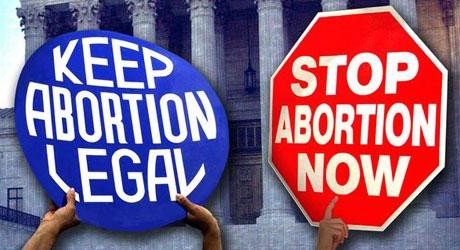 |
| Abortion signs |
Beginning with the prolonged campaign to outlaw abortion led by members of the American Medical Association in the 1860s and 1870s, antiabortion advocates in the United States have frequently used the rhetoric of conspiracy when talking about the practice.
The language of conspiracy was used to describe not only the networks set up to provide abortions but also the ways that those who provided abortions allegedly conspired to conceal the “truth” about the practice and its supposed risks from pregnant women and from the general public.
After the 1973 Supreme Court rulings in Roe v. Wade and Doe v. Bolton struck down state laws criminalizing abortion, antiabortion activists endorsed a number of political strategies, some of which have been called conspiratorial by feminists and others who advocate abortion rights. Beginning in the 1980s, antiabortion leaders such as Randall Terry of Operation Rescue and Joseph Scheidler of the Pro-Life-Action Network recommended “direct action” campaigns targeting abortion providers.
  |
Demonstrations at facilities providing abortion became commonplace, as antiabortion advocates sought to dissuade women from seeking abortions, using means ranging from silent vigils to physically preventing access to the clinic buildings. Since the leaders of these campaigns openly acknowledged that their goal was to drive abortion providers out of business, feminist organizations argued that they were committing criminal conspiracy against those providers.
In 1986, several women’s health organizations filed suit in federal district court, using antitrust laws to charge members of antiabortion organizations with criminal conspiracy. In 1989, the feminist organizations added violations of the federal Racketeer-Influenced and Corrupt Organizations (RICO)
In 1998, a civil jury found the defendants in NOW v. Scheidler guilty of violating RICO laws. The defendants appealed the decision, and in 2003, the U.S. Supreme Court ruled that the antiracketeering laws had been improperly used, nullifying the 1998 decision.
Abortion rights advocates also charge that the increase in acts of direct violence against abortion facilities after 1973 points to conspiratorial action by antiabortion activists. These acts of violence include hundreds of incidents of vandalism, arson and firebombing, the 1982 kidnapping of an abortion doctor and his wife, and a series of shootings at abortion clinics in the 1990s that resulted in seven deaths and a number of injuries.
Additionally, between 1998 and 2001 hundreds of letters claiming to contain anthrax were mailed to abortion clinics around the United States, though they were found to be hoaxes. A number of these actions, including the 1982 kidnapping, a 1993 shooting, and the 1997 bombing of an abortion clinic and a gay bar, have been linked to an organization calling itself the Army of God, which has published a manual outlining methods of vandalizing and bombing abortion facilities and taking credit for several fatal shootings of abortion providers.
This manual, along with the alleged circulation on the Internet of a “hit list” of abortion providers, caused many to believe that the increase in violence against abortion providers in the 1990s was linked to a nationwide conspiracy of antiabortion extremists. A grand jury investigation conducted by the U.S. Department of Justice from 1994 to 1996, however, found no definitive evidence of a national conspiracy.